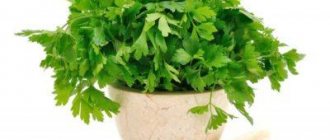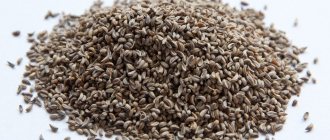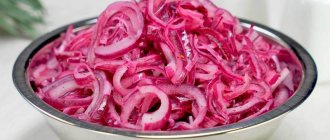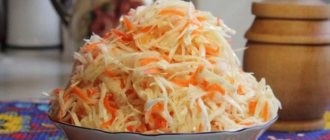Features of planting in the cold season
Many vegetables are planted between autumn and winter. If you sow the seeds of aromatic-spicy parsley in time, they will be covered with snow and they will not freeze on frosty days. And as soon as the snow begins to melt, the grass seedlings will begin to actively develop and begin to grow. And already in the spring you can collect bunches of parsley, fragrant, soft green.
When the seeds successfully overwinter, they become resistant to low temperatures. And after harvesting, you can replant the bed with greens for harvest in October. After planting parsley for the winter, the grass:
- It will be better to tolerate spring frosts;
- will accelerate in development by a month;
- disease resistant;
- ready to eat fresh.
To sow before winter, you need to know what period of autumn is most suitable for this. The period will vary depending on the region. So, in Siberia, planting is carried out earlier than in the Moscow region. Climate and weather conditions play a big role in the timing and rules of sowing parsley in the cold season.
Harvest and storage
Parsley should be collected gradually: as it ripens and is needed. A rational attitude to collecting leaves and roots will provide the gardener with fresh and tasty aromatic greens for a long time.
Methods for storing parsley leaves may vary depending on your needs. For long-term preservation of the harvest, greens can be frozen or dried. And if you need the spice in the near future, then just put it in the refrigerator or prepare it in oil.
The roots of the plant should be stored in a wooden box and in a cool place. For better preservation, it is strongly recommended to cover them with sawdust or sand.
Popular varieties for winter cultivation
Not all vegetable varieties are suitable for planting before winter. The most common greens with early and medium ripening periods are:
- root parsley Russian size with snow-white pulp and a sweetish taste of the underground part of the plant;
- the Eagle variety, unpretentious in care, with a lush leaf rosette;
- Common leaf parsley, frost-resistant, with lush greenery;
- Italian giant of mid-season appearance, quickly growing large green leaves;
- variety of curly parsley Esmeralda.
Varieties are selected in accordance with the purpose of the vegetable crop, resistance to low temperatures and diseases.
Parsley varieties
Early varieties of dill form umbrellas immediately after planting. They do not produce much green foliage and are grown primarily for use in canning. They are sown in early spring. These include the grenadier, Gribovsky. Mid-ripening varieties ripen 6-10 days later than the earliest ripening ones. But they produce more green mass and are better stored (Amazon, Kibray). Late ones ripen in 65-70 days.
Correctly selected varieties according to ripening characteristics ensure an uninterrupted harvest from spring to late autumn.
Parsley is grown not only as an aromatic herb. Varieties of parsley:
- leafy;
- root
Parsley root deceptively looks like a parsnip, with a cone-shaped shape, light beige skin and a rough texture. The root can grow double. It has a dense yet tender texture when raw and a smooth and creamy texture when cooked. The taste has been compared to a combination of celery, parsley and carrots. The tuber is very aromatic. All components of such parsley, roots and tops, are edible. Popular varieties: “Saharnaya” – early ripening, “Urozhaynaya” – mid-ripening variety, “Bordovikskaya” – late ripening. Parsley root is low in calories and contains essential nutrients including vitamin C, folate and fiber.
The leaf is divided into 2 main groups: French or curly leaf; Italian or flat sheet. Of these, group 2 is close to natural wild species. Many people prefer flat-leaf parsley as it is easier to grow, more tolerant of rain and sunlight, and is said to have a stronger flavor. While curly leaf parsley is preferred by others due to its ornamental appearance. “Astra” is an early-ripening variety, “Esmeralda” is a curly-leaved variety with an average ripeness period, “Bogatyr” is a shade-tolerant late-ripening variety.
The best time to plant parsley before winter
You need to sow parsley in the fall at a certain time. When sown early, the spice will begin to sprout quickly, and due to the onset of frost, the tender seedlings will die.
It is necessary to choose the timing of sowing so that the seeds only swell, but do not begin to germinate. Therefore, they choose the time for sowing in October-November, depending on the region and the timing of winter.
Vegetables are sown when the temperature drops below zero at night and reaches 2-3 degrees Celsius during the day. It is best when the weather is clear and slightly frosty on the day of planting parsley. After all, the vegetable is not afraid of the cold and tolerates soil temperatures of 0 degrees.
If the onset of winter shifts and heavy rains begin, the sowing dates are postponed for some time.
See also
How to grow and care for parsley in a greenhouse, how much it grows and what is the yieldRead
When to plant winter parsley
When planting in autumn, it is extremely important to correctly guess the timing of planting seeds in the open ground on the site . If they are sown too early, they may hatch and germinate ahead of time. Fragile and tender sprouts will die from the first severe frosts and in the spring there will be no more greenery harvest. Seed material should be sown in slightly frozen soil, when its top layer is covered with a frosty crust. At the same time, the seeds should not swell and have time to sprout.
The time favorable for planting parsley before winter comes when it is already frosty at night (-5...-2 °C), and during the day it is still quite warm (+1...+3 °C ) . On the territory of our vast homeland, this period varies significantly:
- In the Urals and Siberia, where winter comes early, sowing begins in the second half of September and ends in the first week of October.
- The milder climate of the middle zone allows sowing to be extended until the end of October.
- In the southern regions, characterized by long and warm autumns, winter sowings begin no earlier than mid-November, and sometimes even in December.
In different regions of our country, parsley is planted at different times before winter.
Preparing seeds for planting in open ground
Preparation of parsley seeds is necessary to eliminate low germination of low-quality and affected specimens.
A few days before planting, selected seeds are soaked in a one percent solution of potassium permanganate. It is enough to put them in a gauze bag for 20-30 minutes. Instead of potassium permanganate, solutions of boric acid or copper sulfate are used.
Bubbling, saturating the seed material with oxygen, will increase its resistance to diseases and pests.
More seeds are prepared for winter sowing than in spring. Therefore, procedures with them are carried out more often before planting. Can't do without:
- vernalization, aging in ice;
- panning, enveloping in a mixture of humus, peat, mineral fertilizers;
- hardening with alternate placement in warm and cold water.
Having gone through all stages of preparation, the seeds will show resistance during wintering and will actively begin to germinate after warming up in the sun.
How to choose the right place for autumn planting parsley
After harvesting the vegetables from the garden, they begin to prepare a plot in the dacha for parsley. Vegetable crops need fertile soil with neutral acidity, although a slightly acidic option is also suitable. A vegetable bed is prepared where groundwater does not come close to the surface. Otherwise, when the snow melts, the area will be flooded and the seeds may die.
In order for grass seeds to successfully overwinter, the bed must be in an open place with a lot of snow. For the spring harvest you need more sun than in the shaded corners of your summer cottage.
A place for planting parsley in the fall will be ideal if it has previously harvested potatoes, onions, tomatoes, and cabbage.
You need to know that after collecting the grass, it is better to sow the beds with greens. It is difficult for vegetables to grow after parsley.
Mr. Summer Resident Explains: Ways to Plant Parsley
Parsley can be planted in containers, greenhouses and open ground. Having chosen the first option, you need to follow fairly simple rules. The depth of the grooves should not exceed 1 cm. About 3 cm is left between them. Warmed soil is poured into the grooves along with the seed.
If the climate is harsh, the soil must be mulched. The resulting layer will prevent damage to green sprouts. The containers are covered with film. This is necessary to prevent moisture evaporation.
Grown seedlings are moved to open soil in early May.
To grow in a greenhouse, special equipment may be required. Parsley is most often planted in racks. The distance between rows is calculated based on the characteristic features of the varieties. The landing technology remains the same.
Preparing the soil for planting
To plant greenery in the fall, you need soil in the selected bed:
- thoroughly cleanse of plant waste remaining from cultivated crops;
- loosen;
- nourish with organic and mineral fertilizers;
- moisturize well.
To prevent parsley from being attacked by pathogenic microorganisms or pest larvae during spring germination, all vegetation is raked from the area and destroyed . Loosening the soil will allow you to cope with eggs and pupae of parasitic insects overwintering in the soil. You can pour boiling water or a solution of potassium permanganate over the area.
From organic fertilizers, compost or vermicompost is applied to the garden bed, up to 5 kilograms per 1 square meter. It is also necessary to feed with granules of superphosphate and potassium salt, 20 grams of each substance. The same amount of fertilizer containing nitrogen is added. To improve the permeability of the soil, coarse river sand or fine-grained crushed stone is mixed into it.
The grooves for planting seeds are made in advance with a depth of 5 centimeters, covering them with film so that rain does not damage the integrity of the bed.
About parsley seeds and features of their sowing
Due to the fact that the seeds of parsley are very small, their consumption is small: leaf - 7-8 grams per 10 square meters of area; root - for the same area - 3-3.5 grams. But when sowing in autumn, this norm, which is intended for spring sowing, should be doubled, because by spring, despite the fact that they are not afraid of -9 C, they may not all survive in harsh winters with little snow.
Plants can be placed in the garden bed in rows (lines) with a row spacing of 30-45 centimeters or in two-line and multi-line stripes, the distance between which is 50-60 centimeters, and between the lines - 12-15 centimeters. Stitches, shallow grooves up to 2-3 centimeters, are drawn using a sharp angle of a hoe along a twine cord so that the rows are even in the spring. The furrows sown with dry parsley seeds are filled with dry soil, previously stored in some container in case the ground freezes. Next, the bed is covered with mulch and compacted.
Fall sowing of leaf parsley is more desirable, most likely because it is an annual plant. But root parsley, a two-year vegetable, will produce a harvest of root vegetables only in the second year, and there is little point in rushing its seedlings. For your information! The green part of parsley is dried, ground in its dried form, sifted through a sieve, and the resulting green powder becomes a convenient and good seasoning for all first courses and most second courses.
Sowing parsley seeds
Having chosen a suitable day for sowing parsley before winter, remove the film material. A thin layer of dry sand is poured into the grooves. They take a third more seeds than usual. This will avoid a lack of seedlings in April.
Having placed the seeds in the grooves, sprinkle dry soil, nutritious and loose, on top, and lightly compact them.
See also
Useful properties and contraindications of parsley for weight lossRead
All that remains is to protect the plantings from frost and retain moisture and nutrients in the furrows. For this purpose, cover the bed with a layer of mulch consisting of peat, humus or chopped straw, and dry leaves.
If the weather is rainy, without reducing the air temperature, you can cover the beds with film. The material will save parsley from moisture getting into the soil and premature germination of seeds.
After the spring sun begins to heat up, the parsley seeds become active and grow, receiving enough moisture.
Site selection and preparation
For parsley, you need to choose an open place, well illuminated by the sun's rays, protected from cold winter winds, where there is a lot of snow . Low-lying areas that are flooded in spring or with close groundwater are not suitable. This green crop develops best in light, loose, well-drained soils with a neutral or slightly acidic acidity level.
Various vegetables (cabbage, potatoes, tomatoes, onions, garlic, etc.) are considered the best predecessors. You cannot plant parsley where its closest relatives (dill, celery, carrots, etc.) previously grew.
Parsley loves sunny areas, but can also grow in light partial shade.
The bed intended for winter sowing of parsley is prepared in advance (3–4 weeks) so that the soil settles and compacts . The technology is like this:
- The earth is carefully dug up to a depth of 20–25 cm, simultaneously selecting the rhizomes of perennial creeping weeds (wheatgrass, bindweed, sow thistle, etc.).
- When digging, fertilizers are applied (per 1 m2):
- humus or garden compost - 5–6 kg;
- potassium sulfate - 10–12 g;
- superphosphate - 12–15 g;
- ammonium nitrate - 15–20 g.
- Carefully level the soil surface using a rake.
- Using a board or a long ruler, make parallel grooves about 4.5–5 cm deep in the garden bed, leaving about 15–20 cm between them.
The furrows in the garden bed are made in advance
- A thin layer (1–1.5 cm) of dry sand is poured onto the bottom of each groove.
- The prepared bed is covered with plastic film to prevent it from being washed away by precipitation.
- Collect some soil (1-2 buckets) and store it in a warm room.
To disinfect the soil, about a week before the expected planting day, thoroughly spill it with a pink solution of potassium permanganate (1%).
Proper plant care
Before the onset of winter, it is better to cover the beds with parsley if they are located in places where little snow accumulates. For shelter, leaves are raked over the area or straw is laid. During a snowy winter, you can engage in snow retention by installing special shields.
In April, after the snow melts, spicy grass shoots appear. Now they need watering several times a week. Moisten parsley seedlings with warm water in the evening.
After the sprouts become larger, they need to be thinned out, leaving large, healthy specimens. After the third thinning, the distance between the parsley stems should be within 10 centimeters.
Greens need feeding. Fertilizers are applied in the form of organic matter, using mullein diluted in a ratio of 1:6, or bird droppings in a solution with a concentration of 1:15.
Of the mineral fertilizers for growing greenery, you need nitrogen contained in ammonium nitrate, as well as potassium and phosphorus. The vegetable plant will obtain the last element from wood ash. The solution is prepared from 100 grams of ash per 10 liters of water. Fertilizing is applied every 2 weeks, the first before the grass leaves begin to bloom .
It is important that you need to feed plants in moderation. Excess fertilizer can make herbs tough and tasteless. But it makes no sense to abandon them when the soil is severely depleted in nutrients.
Seedlings must be protected from weeds. They are removed as they appear, since weeds become a source of infection with fungal infections and parasite larvae.
Caring for winter parsley in spring and summer
Caring for parsley planted in the fall will not be difficult - it is enough to carry out standard agricultural work in a timely manner. These include watering, fertilizing, loosening the soil and regularly removing weeds. When the first shoots appear in the spring, experienced gardeners recommend covering the parsley with a translucent film - this way the crops will favorably survive the aggressive influence of the environment. As soon as 2-3 true leaves become noticeable on the sprouts, the parsley will need to be thinned out.
Experienced gardeners usually carry out this procedure twice - the first time in order to form beds in which the strongest and healthiest shoots should remain, and the second time after the appearance of 6-7 leaves. Then the distance between the rows is significantly reduced to 5–6 cm. In addition to thinning, the crop also needs to loosen the soil - however, you should start this procedure only after stable warm weather has established. In this case, it is necessary to carefully monitor the structure of the soil - it should not be overly dense.
Harvesting
Parsley is grown before winter for fresh consumption. Therefore, as soon as the leaves and stems reach maturity, they are cut off. To use for a long time, you should immediately put the herb in the refrigerator, in bags, providing the greens with air access. Don’t forget to sort out the shoots and dry them before planting.
To ensure juiciness of parsley leaves, it is necessary to water the bushes more abundantly before cutting. If root varieties of the plant are grown, then dig out the white fragrant roots in May-June. They are cut and placed in the freezer.
The stems of herbs are cut at the root, rather than plucked out at the tops. This will allow young shoots to grow, and then the grass will actively develop until autumn. It is better to take several stalks of grass for salad from the outside of the bush without violating its integrity.
When the curly leaves of the plant begin to turn yellow, the shoots are completely cut off to be stored and used for cooking.
If you follow the rules for growing parsley before winter and carefully care for the plantings, you can achieve a high yield of greenery. It will provide summer residents with vitamins and beneficial microelements until the next time the herbs are cut.











